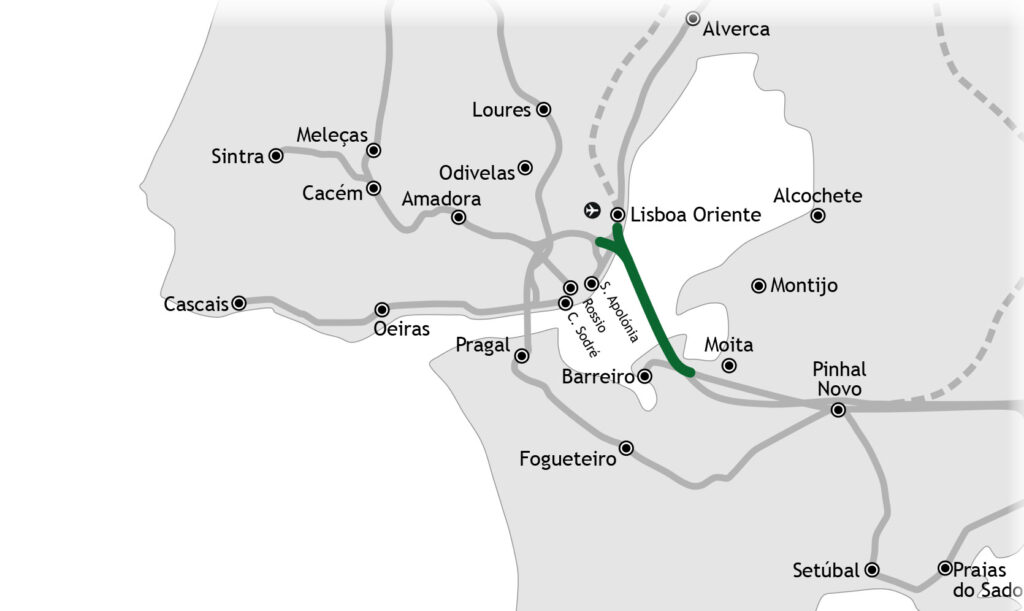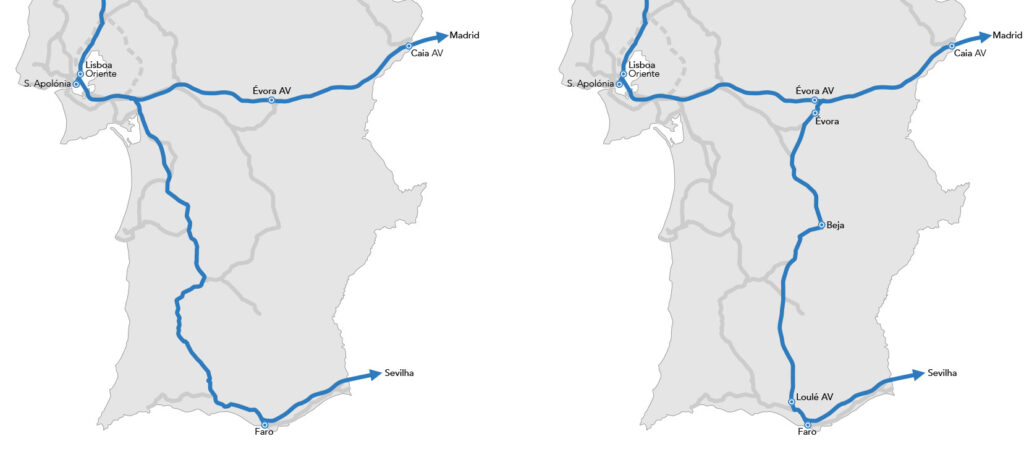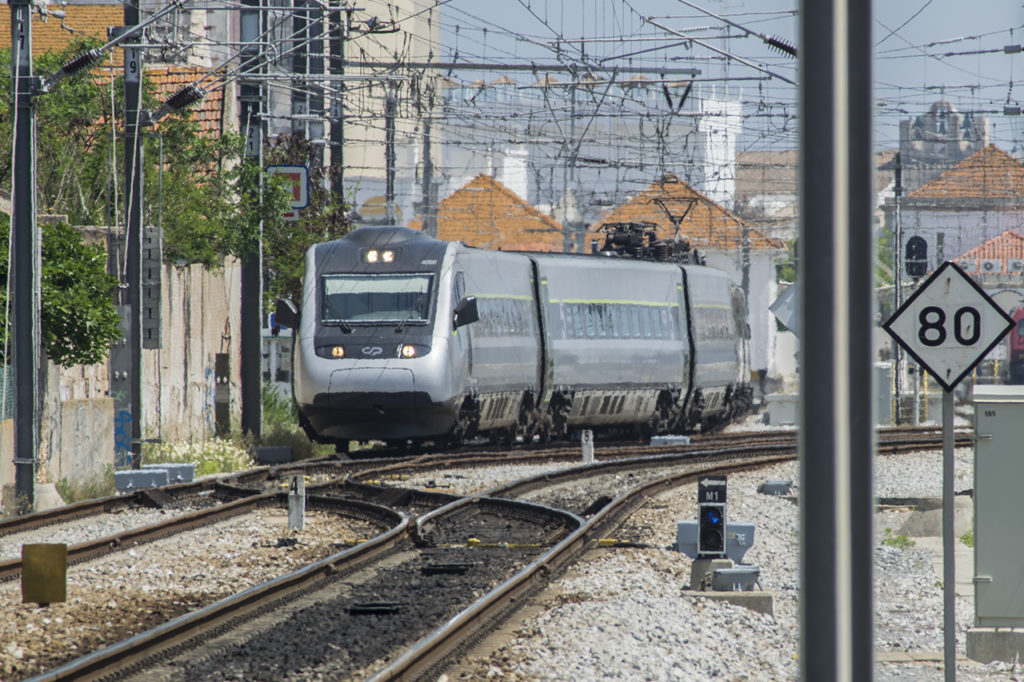Travel times by train from Lisbon to the Algarve and Alentejo will decrease by around 30 minutes, from the moment the 3rd crossing of the Tagus is completed, in Lisbon, a work foreseen in the National Railway Plan.
The same document raises the possibility of investments in the South Line, pointing out two alternatives, one of which is the construction of a new section that places Faro, Beja and Évora on the same axis, which would reduce the travel time between the Algarve capital and Lisbon to less than two hours, more precisely 1h55, on the Alfa Pendular service.
However, what should go ahead soon is the 3rd crossing of the Tagus, in the Lisbon Metropolitan Area.
«The investment with the greatest positive impact on the connections between Lisbon and the Alentejo and Algarve is the construction of a new railway crossing over the Tagus in Lisbon. It is, perhaps, the most important piece missing from the national rail network, as it is the one that allows to mitigate the effect of the Tagus River as the main obstacle to mobility between the whole South and Lisbon, without forgetting the Center and North of the Country» , it reads in the version of the plan recently approved by the Council of Ministers and which will still be subject to Public Consultation.
This is because, despite being «an investment located in the capital, it has a great effect on the territorial cohesion of the country as a whole», the document argues.
This new train crossing of the Tagus «has already been extensively studied» and there is a consolidated option: «a alignment between Chelas, on the north bank, and Barreiro, on the south bank».

«This alignment would be inserted on the Cintura Line and the North Line, in the Braço de Prata area, Lisbon, and on the Alentejo Line, in the Lavradio area, Barreiro, allowing, in addition to long-distance services, the creation of new suburban services', according to the plan.
This alternative solves some problems that currently exist, first of all the limitations on the capacity of crossing the 25 de Abril Bridge, «resulting, in part, from its insertion on the Belt Line».
«In addition, from the point of view of intercity passenger services, it implies a travel time of never less than 42 minutes between Lisbon Oriente and Pinhal Novo station, still within the Lisbon Metropolitan Area. With the new crossing, this time is reduced to about 15 minutes, which means shortening all connections from Lisbon to the Alentejo and the Algarve by about 30 minutes, as well as increases in the frequency of services», the document anticipates.
This is, in itself, good news for those who live in the districts of Évora, Beja and Faro, which would have a faster rail connection to Lisbon and the rest of the country.
But it might not be the only one.
The plan admits two possibilities, alternatively to each other, to «obtain additional gains in travel time on the connection between Lisbon and the Algarve».
One of them is “the modernization of the Southern Line, which currently runs all trains bound for the Algarve, with a significant investment in route corrections between Torre Vã and Tunes and possible additional investments north of Torre Vã”.

The other is «the construction of a new connection that would include Évora and Beja on the same Lisbon-Algarve axis».
The first advanced solution and the easiest to implement, «since it is a relatively modest investment», is the correction of the route between Torre Vã and Tunes, which «could make it possible to save an additional 10 to 15 minutes» on this section, «putting travel time between Lisbon and Faro in about 2h15».
However, if you want to reduce the travel time between Lisbon and Faro for less than two hours «a much heavier investment will be necessary on the Southern Line. In addition, there is the possibility that, in the long term, the Southern Line will suffer capacity constraints».
Another issue that has to be considered is Portugal's ambition to see the Algarve Line integrated into the Iberian network, extending the corridor from Faro to Huelva and Seville.
The remodeling of the Torre Vã-Tunes section «may be insufficient to ensure adequate connections to the south of the country».
The plan highlights, even so, that it is “certain that the Torre Vã-Tunes section needs a rehabilitation intervention during the next decade”. What will be its extension depends on the alternative chosen.
And the other alternative is much more ambitious – and, as such, more costly and, it is anticipated, more controversial, due to possible environmental impacts.
The plan envisages that, as an alternative, the study of «the creation of a connection that, in addition to allowing reductions in travel time, puts the cities of Évora, Beja and Faro on the same axis".
«In this way, the three district capitals would be served more frequently, as a result of the concentration of traffic on the same axis, as opposed to its division into different branches of a tree network», frames the document.
The idea on the table takes advantage of «a significant part of the Évora and Alentejo Line, with the construction of a concord between these two lines and a new route south of Beja, with maximum circulation speeds between 200 km/h for the existing lines and 250 km/h on part of the new route, corresponding to about half the distance between Évora and Faro».
«With these hypotheses, it is possible to show a travel time of less than two hours between Lisbon and Faro, with stops in Évora and Beja. Combined with building a link between Faro and Seville on similar terms, this would enable a travel time between Lisbon and Seville of less than four hours, assuming the same approach, making use of some sections of the existing lines and building a new line on the remaining ones», reads in the National Railway Plan .

In any of these cases, the works are to be carried out in the long term, especially if the alternative chosen is the creation of a new connection.
Prior to that, and taking into account that the new crossing of the Tagus is a priority, the reopening of the Alentejo Line between Beja and Ourique will make it possible «for some of the Intercity services between Lisbon and the Algarve to circulate through Beja or, equivalently, consider extending the Intercity Lisbon-Beja to Faro, without penalizing too much travel time between the extremes».
«Thus, the two cities are placed on the same railway axis, concentrating traffic and allowing accessibility between them. The travel time will be similar to what currently exists on Intercidades on the Southern Line. In this way, another ring in the national railway network is closed», refers to the plan.
The time savings resulting from the new bridge will also allow «resuming the service to Alcácer do Sal without compromising the total travel time».




















Comments